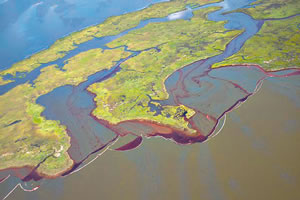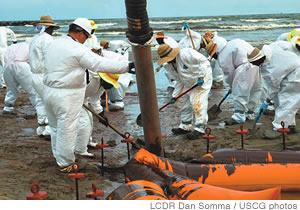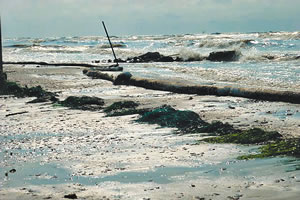Local Coast Guardsmen At The Spill

Aerial view of Barataria Bay. You can see the white boom stretched out that is used to either protect an area from oil impact or keep it in one place for later recovery
On April 20, the world watched in awe and sadness as emergency crews responded to the Deepwater Horizon drilling explosion in the Gulf of Mexico.
Eleven workers were killed and 17 injured, but the tragedy was still unfolding.
The explosion quickly turned into the spill, the largest offshore oil spill in U.S. history with hundreds of millions of gallons lost at sea. Thousands responded to the disaster including United States Coast Guard Lt. j.g. Ryan Dickson.
“I was one of the first responders to the incident moments after the explosion,” says Dickson, who was stationed in the Gulf of Mexico at the time but now is with the District 14 unit in Honolulu.
“It was a very somber atmosphere but very professional. We had two major focuses in the first 72 hours. First, make sure everyone was safe and accounted for and simultaneously respond to the immediate environmental concerns.”
Dickson and others initially worked 12- to 18-hour days, mobilizing command posts while preparing civilian and private vessels with oil skimming equipment. He recalls the need to stay focused in what he described as “arduous conditions.”

Shoreline workers conduct clean up of pooled oil on beaches at Grand Isle. The long tube is connected to a large vacuum truck that sucks up the oil and stores it in a tank
“It was an unforgiving atmosphere, with really harsh conditions – heat, humidity and bugs took their toll,” says Dickson.
Chief marine science technician Dustin Widman understands what Dickson is talking about. Widman returned from a 30-day deployment to the gulf in late June. Widman was at Grand Isle, a seven-mile strip of land near Louisiana that is home to roughly 1,500 residents.
“For them, tourism is a huge deal, and the oil spill was a big impact,” says Widman. “The local residents understood why we were there and for the most part the Coast Guard was well received and appreciated.”
Widman has been with the Guard for 11 years and like Dickson he had never experienced anything like this before.
The spill’s environment was so vast each area had its own command post.
“We implemented everything we are trained to do and use,” he says. “No one was experienced with something this large, but once people got their hands around it, it was really awesome. We all went way past our comfort zones.”
Dickson says while officials and employees of British Petroleum worked to stop the spill, he witnessed the human spirit at its best, Americans coming together in tragedy.
“It was fulfilling, even though you’re just one piece, you know this is a huge response with so many people and everyone is there to make sure things happen the way they’re supposed to.”

A shoreline view of Elmer's Island. What look like pebbles are actually small tar balls. Also shown are pom poms (looks like seaweed) and sorbent boom, both used to capture oil that comes ashore
It’s something we often see following a disaster or tragedy, people rallying when it matters most.
It is especially true when turning back the clock is not an option. In this case, moving forward with new knowledge may one day save lives.
“I hope it doesn’t happen again, but if it does we’ll be prepared,” says Dickson. “I have some experiences to look back on because this was an unprecedented response.”
Both Dickson and Widman say responding to the spill provided a valuable learning environment that can never be simulated.
The world is hopeful it is never duplicated.
You must be logged in to post a comment.




There are no comments
Add yours